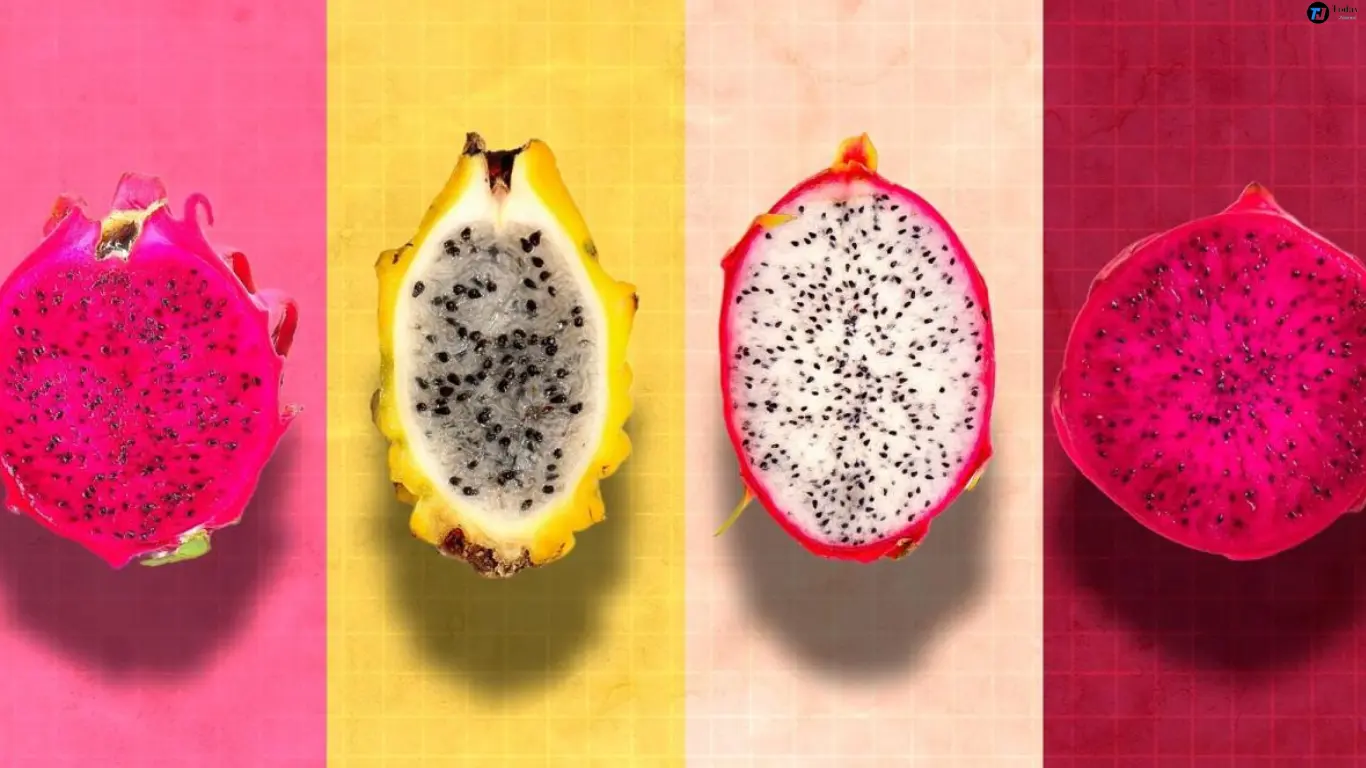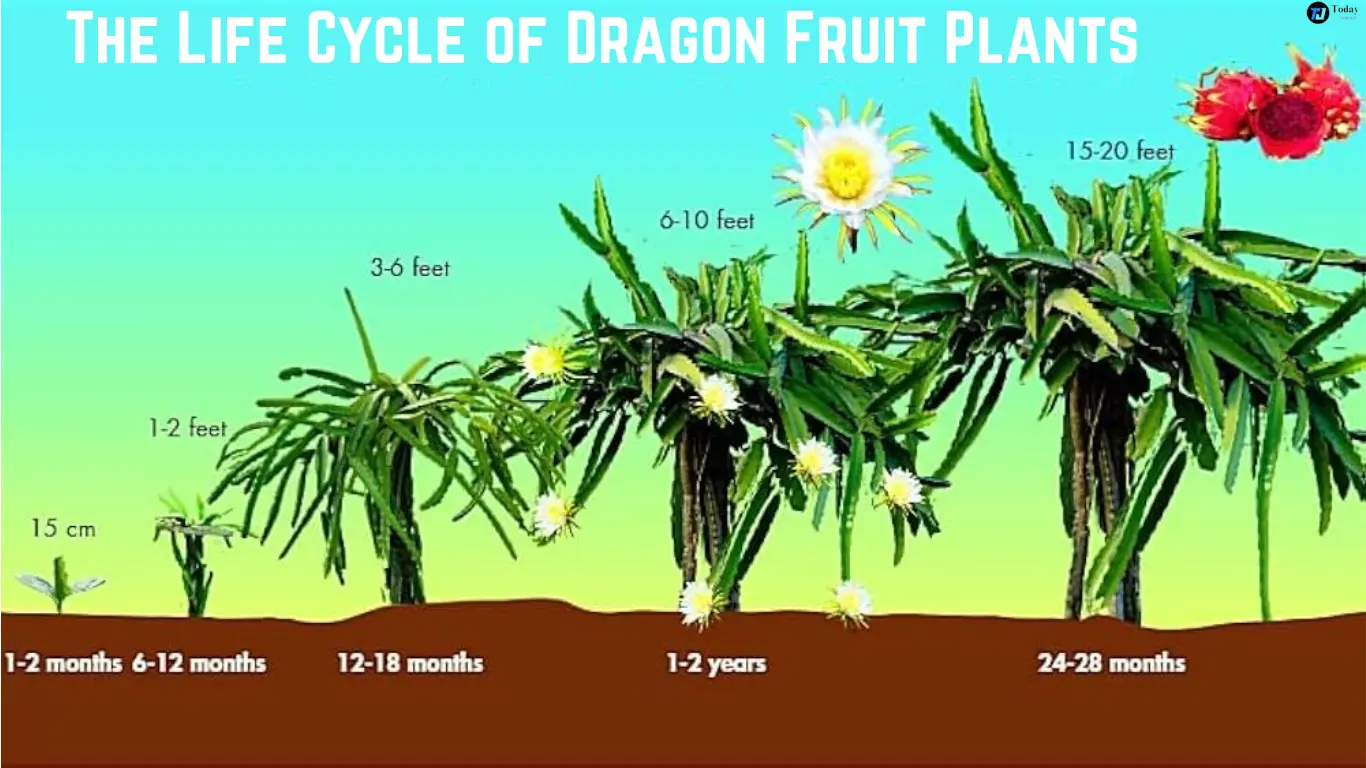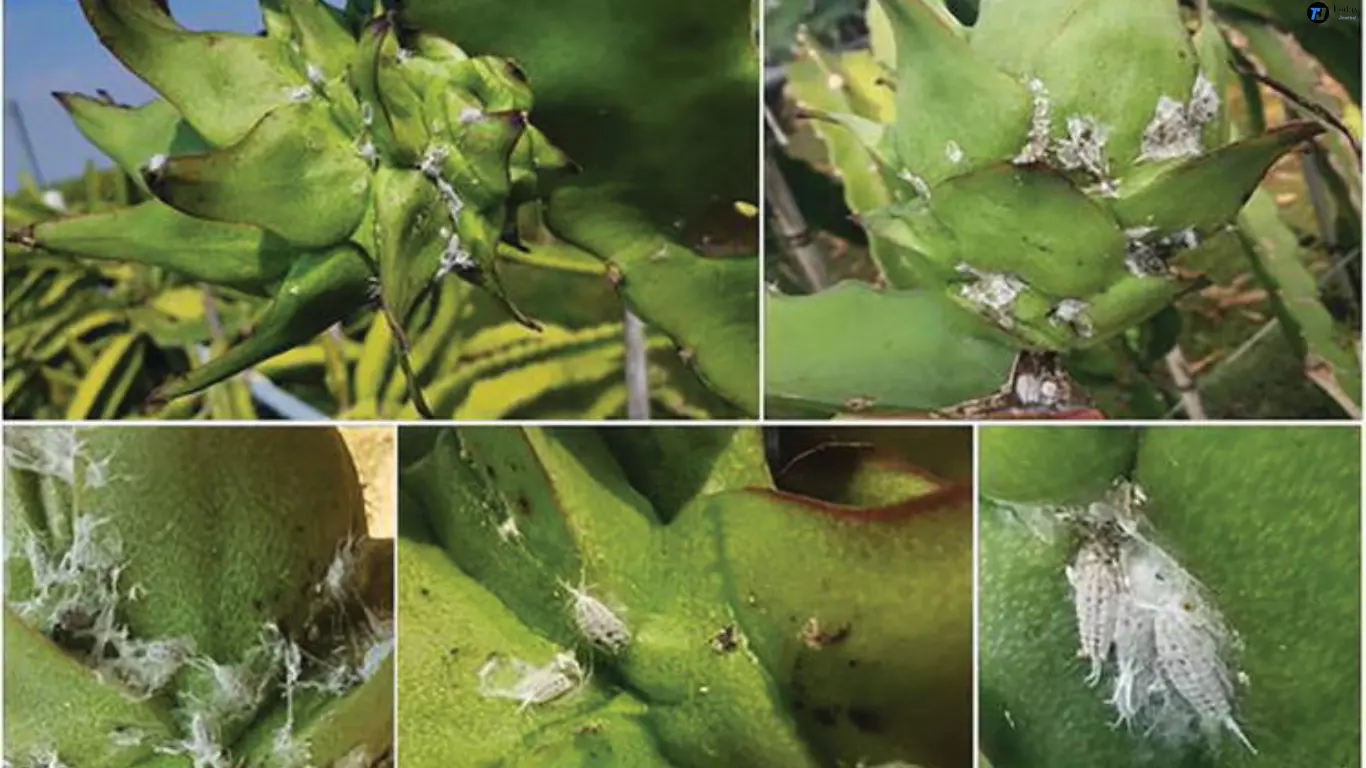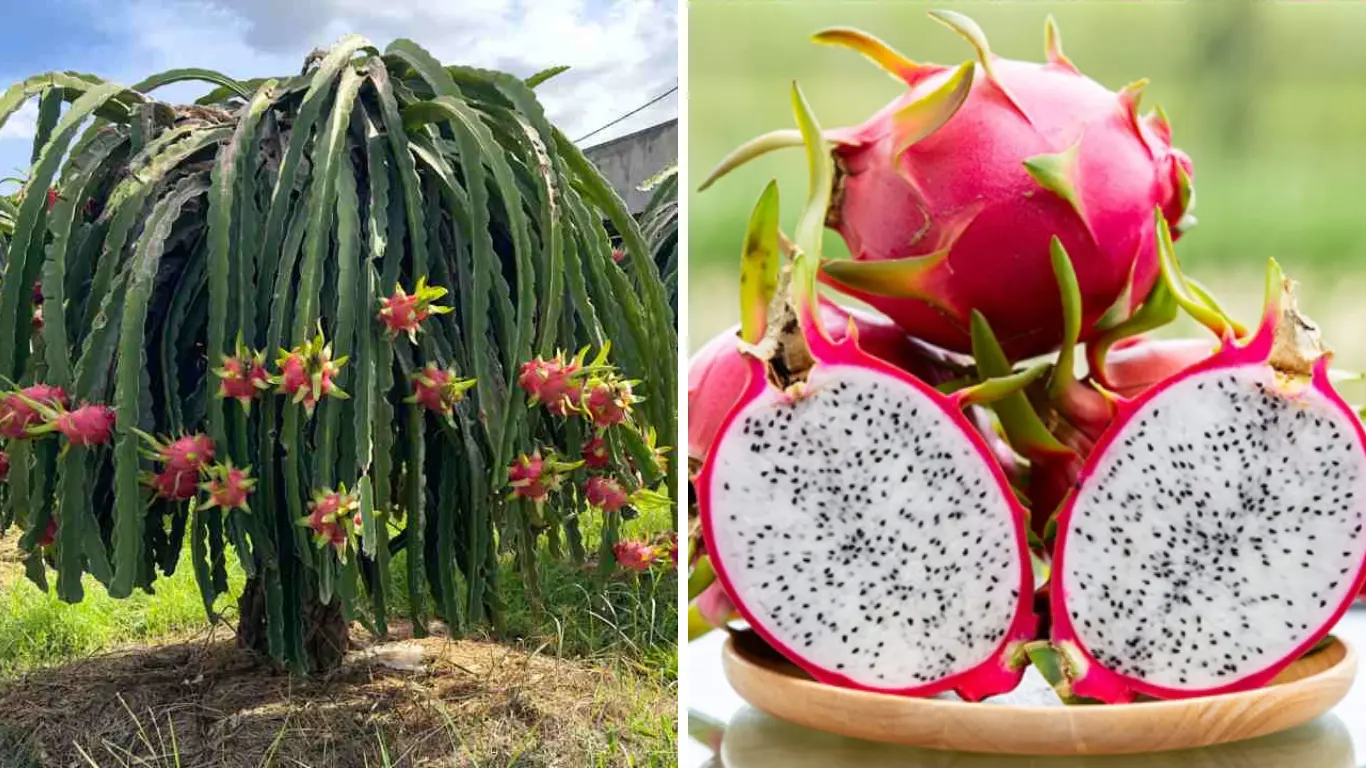Dragon fruit, also known as pitaya, is a colorful and exotic fruit. It grows on a cactus plant. Many people love its sweet taste and bright look. In this article, we will explore the dragon fruit plant, how to grow it, and how to care for it.
What Is a Dragon Fruit Plant?
The dragon fruit plant belongs to the cactus family. It has long, green stems that can grow tall. The stems can reach up to 20 feet. They have spiky edges and grow like vines. This plant produces large, bright flowers that bloom at night.
The flowers are beautiful and attract many pollinators. Bees and bats love them. After the flowers bloom, the fruit starts to grow. The dragon fruit is usually bright pink or yellow. It has green scales that look like dragon skin, giving it its name.
How to Grow a Dragon Fruit Plant
Growing a dragon fruit plant is simple. You need a sunny spot in your garden. The plant loves warm weather. Here are some tips to help you grow your dragon fruit:
- Choose the Right Location: Pick a sunny area. Dragon fruit plants need at least six hours of sunlight each day.
- Soil Type: Use well-draining soil. A mix of sand, peat, and compost works well.
- Planting: Plant seeds or cuttings in the spring. Make sure they are a few inches deep in the soil.
- Watering: Water the plant once a week. Do not let it sit in water. It can rot if it’s too wet.
- Support: As the plant grows, provide a trellis or support. The stems are long and need something to climb on.
By following these steps, you can successfully grow your dragon fruit plant.
Caring for Your Dragon Fruit Plant
Once your dragon fruit plant is growing, you need to take care of it. Here are some easy care tips:
- Fertilization: Feed your plant every month. Use a balanced fertilizer. This helps it grow strong and produce fruit.
- Pruning: Trim the plant regularly. Remove dead stems or leaves. This keeps the plant healthy and encourages new growth.
- Pest Control: Watch for pests like aphids and mealybugs. Use insecticidal soap if needed. Keep your plant clean and free of pests.
- Harvesting: Dragon fruits usually ripen in summer. They are ready when they turn bright color and feel soft. Pick them carefully to avoid damaging the plant.
Taking care of your dragon fruit plant is easy. With the right attention, it will thrive and produce delicious fruit.
Benefits of Growing Dragon Fruit
Growing a dragon fruit plant has many benefits. Here are some of them:
- Tasty Fruit: The fruit is sweet and refreshing. It is great in smoothies, salads, or on its own.
- Health Benefits: Dragon fruit is full of vitamins and minerals. It has vitamin C, calcium, and antioxidants.
- Unique Look: The plant adds a beautiful touch to your garden. Its bright colors make it stand out.
- Easy to Grow: The dragon fruit plant is low-maintenance. It does not require much care compared to other plants.
These benefits make growing a dragon fruit plant a fun and rewarding experience.
Common Varieties of Dragon Fruit

There are several types of dragon fruit plants. Each variety has its own unique flavor and appearance. Here are some popular ones:
- Hylocereus undatus: This variety has white flesh and pink skin. It is the most common type. The fruit is sweet and juicy.
- Hylocereus costaricensis: Known for its red flesh, this variety is also pink on the outside. It has a slightly more intense flavor than the white-fleshed type.
- Hylocereus megalanthus: This variety has yellow skin and white flesh. It is sweeter than the other types and has a unique taste.
- Selenicereus spp.: This type has white flesh and is known for its long, slender fruit. It is less common but still delicious.
These varieties offer different tastes and colors. You can choose one based on your preference or try them all!
Dragon Fruit Plant in Different Regions
Dragon fruit plants grow in many regions around the world. They thrive in warm, tropical areas. Here’s a look at where they are commonly found:
- Central America: Dragon fruit is native to regions in Central America. It has been grown there for centuries.
- Asia: Countries like Vietnam and Thailand cultivate dragon fruit on a large scale. The fruit is popular in local markets.
- United States: In the U.S., dragon fruit grows well in California and Florida. Gardeners there enjoy growing this exotic fruit.
Understanding where dragon fruit thrives helps in its cultivation. Each region has its own way of growing and using the fruit.
How to Use Dragon Fruit in Your Diet
Dragon fruit is not only delicious but also versatile. You can use it in various dishes. Here are some fun ways to enjoy dragon fruit:
- Smoothies: Blend dragon fruit with yogurt, bananas, and berries. This makes a refreshing smoothie.
- Fruit Salads: Add chopped dragon fruit to a fruit salad. It adds color and sweetness.
- Salsa: Mix diced dragon fruit with onions, cilantro, and lime juice. This creates a tasty salsa for chips.
- Desserts: Use dragon fruit in sorbets or ice creams. It adds a unique flavor to sweet treats.
- Garnish: Use slices of dragon fruit to decorate cakes or other desserts. Its bright color makes everything look better.
The Life Cycle of Dragon Fruit Plants

Understanding the life cycle of dragon fruit plants can help you care for them better. Here’s a brief overview of what happens:
- Germination: The plant starts as a seed. It needs warmth and moisture to germinate.
- Seedling Stage: After germination, seedlings grow for a few months. They develop small leaves and begin to establish roots.
- Vegetative Growth: The plant grows longer stems and branches. This is the stage where it starts to climb.
- Flowering: The plant produces large, white flowers at night. Pollination usually occurs at night as well.
- Fruit Development: After pollination, the fruit starts to form. It takes several weeks to ripen.
Knowing the life cycle helps you provide the right care at each stage.
These ideas show how easy it is to include dragon fruit in your meals.
Environmental Benefits of Dragon Fruit Plants
Growing dragon fruit plants can also help the environment. Here are some benefits:
- Air Quality: Like all plants, dragon fruit helps improve air quality. It absorbs carbon dioxide and releases oxygen.
- Soil Health: The roots of the dragon fruit plant help prevent soil erosion. They hold the soil in place and keep it healthy.
- Biodiversity: Growing different plants, like dragon fruit, supports biodiversity. It attracts various pollinators and insects.
By planting dragon fruit, you contribute positively to the environment.
Tips for Successful Dragon Fruit Cultivation
If you want to grow dragon fruit successfully, keep these tips in mind:
- Choose Disease-Resistant Varieties: Some dragon fruit varieties are more resistant to diseases. This will save you time and effort.
- Watch for Signs of Stress: Keep an eye on your plant. Yellowing stems or wilting can be signs of stress. Adjust watering or sunlight as needed.
- Provide Enough Space: Dragon fruit plants can spread out. Give them plenty of room to grow without crowding.
- Rotate Crops: If you plant other crops, rotate them regularly. This helps keep the soil healthy and free from pests.
These tips will help ensure your dragon fruit plant flourishes.
Pest and Disease Management for Dragon Fruit

While dragon fruit plants are generally hardy, they can still face pest and disease issues. It’s important to monitor your plant regularly. Here are some common pests and how to manage them:
- Aphids: These tiny insects can suck the sap from your plant. If you see them, wash them off with water. You can also use insecticidal soap.
- Mealybugs: These bugs look like little cotton balls. They can damage your plant by feeding on it. Remove them by hand or use neem oil to eliminate them.
- Snails and Slugs: These pests can munch on the fruit and leaves. Place traps or barriers to keep them away.
For diseases, root rot is a common issue. This happens if the plant gets too much water. Ensure your soil drains well and avoid overwatering.
Fun Facts About Dragon Fruit
Dragon fruit is not only unique in appearance but also interesting in many other ways. Here are some fun facts about this amazing fruit:
- Night Bloomer: Dragon fruit flowers bloom only at night. This attracts nocturnal pollinators like bats.
- High in Fiber: Dragon fruit is rich in dietary fiber. This makes it great for digestion.
- Colors and Varieties: Dragon fruit comes in various colors, including pink, yellow, and white. Each has its own flavor.
- Symbol of Wealth: In some cultures, dragon fruit is seen as a symbol of good luck and prosperity.
- Growing Popularity: Dragon fruit is becoming more popular worldwide. People love its taste and health benefits.
These facts make dragon fruit even more fascinating!
Companion Planting with Dragon Fruit
Companion planting is a gardening technique where you grow different plants together. This can benefit both plants. Here are some good companions for dragon fruit:
- Citrus Trees: Citrus trees like oranges or lemons can grow well with dragon fruit. They enjoy similar soil and sunlight needs.
- Herbs: Basil and mint are great companions. They help repel pests that might harm the dragon fruit.
- Beans: Planting beans near dragon fruit can help fix nitrogen in the soil. This benefits both plants.
Companion planting can improve growth and help control pests naturally.
Cooking and Serving Dragon Fruit
When it comes to preparing and serving dragon fruit, there are many fun options. Here are some easy ideas for using dragon fruit in your kitchen:
- Cut and Serve: Simply cut the fruit in half and scoop out the flesh. Enjoy it fresh as a snack.
- Add to Breakfast: Slice dragon fruit and add it to yogurt or oatmeal. It adds color and flavor.
- Frozen Treats: Blend dragon fruit with coconut milk and freeze it. You can create delicious popsicles.
- Dragon Fruit Bowls: Use dragon fruit as a base for smoothie bowls. Top with granola, nuts, and other fruits for a colorful dish.
These simple ideas can help you enjoy dragon fruit in many delicious ways.
Common Myths About Dragon Fruit
Despite its popularity, there are several myths surrounding dragon fruit. Here are some common misconceptions:
- Myth: Dragon Fruit is a Cactus Fruit
Truth: While dragon fruit comes from a cactus, it is not just a cactus fruit. It belongs to the Hylocereus genus, which is a climbing cactus. - Myth: All Dragon Fruit Tastes the Same
Truth: Different varieties of dragon fruit have distinct flavors. Some are sweeter, while others are milder. - Myth: You Can’t Grow Dragon Fruit in Cold Weather
Truth: While dragon fruit prefers warm climates, it can survive in slightly cooler temperatures with proper care. Use frost covers in winter if necessary. - Myth: Dragon Fruit is Poisonous
Truth: Dragon fruit is completely safe to eat. It is nutritious and has no toxic parts.
By knowing the truth behind these myths, you can appreciate dragon fruit even more.
How to Propagate Dragon Fruit Plants
Propagating dragon fruit is easy and can be done in two ways: from seeds or cuttings. Here’s how:
From Seeds:
- Collect Seeds: After eating the fruit, save the tiny seeds inside.
- Dry the Seeds: Allow the seeds to dry for a few days.
- Prepare Soil: Use a well-draining potting mix.
- Plant the Seeds: Sow the seeds on the surface of the soil. Cover lightly with soil.
- Water Gently: Water carefully to avoid washing away the seeds.
From Cuttings:
- Choose a Healthy Stem: Cut a healthy stem about 12 inches long.
- Let it Callus: Place the cutting in a dry spot for a few days. This allows the cut end to callus over.
- Plant the Cutting: Plant the callused end in well-draining soil.
- Water Sparingly: Water lightly until you see new growth.
Both methods will help you grow new dragon fruit plants successfully.
Seasonal Care for Dragon Fruit Plants
Seasonal changes can affect how you care for your dragon fruit plant. Here are tips for each season:
Spring:
- Planting Time: Spring is the best time to plant new dragon fruit.
- Fertilization: Start fertilizing as the plant begins to grow. Use a balanced fertilizer.
Summer:
- Watering: Increase watering during hot months. Keep the soil moist but not soggy.
- Pest Monitoring: Watch for pests as they may be more active in the summer.
Fall:
- Pruning: Trim any dead or damaged stems. This helps promote healthy growth.
- Reduce Watering: As temperatures cool, reduce watering.
Winter:
- Protection from Cold: If you live in a cooler climate, protect your plant from frost. Use covers or bring potted plants indoors.
- Minimal Watering: Water less frequently during the winter months.
Adjusting your care based on the season will help your dragon fruit plant thrive year-round.
Using Dragon Fruit in Beauty and Skincare
Dragon fruit is not just delicious; it also has beauty benefits. Here are some ways to use it for skincare:
- Face Masks: Blend dragon fruit and mix it with honey. Apply it to your face for a natural mask. It hydrates and brightens the skin
. - Hair Conditioner: Use dragon fruit puree as a hair conditioner. Apply it to your hair and rinse after 30 minutes. It can add shine and moisture.
- Exfoliating Scrub: Mix dragon fruit with sugar or sea salt to create a gentle scrub. Use it to exfoliate your skin.
These natural remedies show that dragon fruit can be beneficial for beauty too!
Final Thoughts on Dragon Fruit Plant
Growing a dragon fruit plant is a rewarding experience. You can enjoy its beautiful flowers, unique fruit, and health benefits. With a little care, your plant will thrive.
Whether you are a beginner or an experienced gardener, dragon fruit is a great choice. It’s fun to grow, easy to care for, and delicious to eat. Consider adding a dragon fruit plant to your garden today!
Conclusion
The dragon fruit plant is a fantastic addition to any garden. It is easy to grow and care for. With its colorful fruit and health benefits, it is worth the effort. Try growing a dragon fruit plant today, and enjoy its unique beauty and taste!
| Visit my homepage for more information, articles, and news. |
Frequently Asked Questions – FAQs
How long does it take for a dragon fruit plant to produce fruit?
It usually takes about 1 to 3 years for a dragon fruit plant to bear fruit after planting.
Can I grow dragon fruit in a pot?
Yes, you can grow dragon fruit in a pot. Just make sure the pot has drainage holes and is big enough for the roots.
What is the best climate for growing dragon fruit?
Dragon fruit grows best in warm, tropical, or subtropical climates. It likes temperatures between 65°F and 100°F.
How often should I water my dragon fruit plant?
Water your dragon fruit plant once a week. Be careful not to overwater it.
Can I eat dragon fruit skin?
The skin of the dragon fruit is not edible. It is tough and not tasty. Focus on the sweet fruit inside instead.




